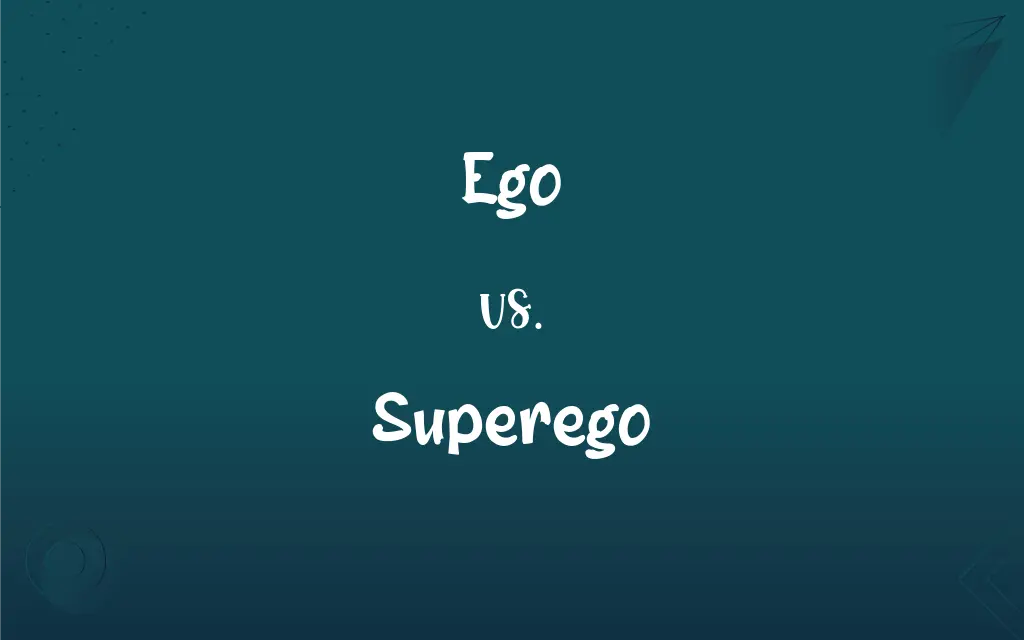Ego vs. Superego: What's the Difference?
Edited by Janet White || By Harlon Moss || Updated on October 21, 2023
The ego is the conscious, rational part of the mind, mediating between desires and reality, while the superego represents internalized moral standards and ideals.

Key Differences
The ego operates based on reality, trying to satisfy the id's desires in a socially acceptable manner. The superego, on the other hand, strives for moral perfection, often judging the ego's actions.
Freud introduced the ego as the mediator between the primitive desires of the id and the moralistic demands of the superego. While the superego is our moral compass, the ego ensures actions meet societal norms.
An individual's ego is constantly at work, striving to find a balance between basic desires and moral values, often influenced by the superego. The superego, rooted in learned values, critiques and guides the ego.
The ego utilizes defense mechanisms to manage the tension between the id and the superego. Meanwhile, the superego serves as the conscience, celebrating or condemning the ego's decisions.
A balanced relationship between the ego and the superego is crucial. If the ego is too dominant, the person may become selfish. If the superego is too dominant, they may become overly moralistic or guilt-ridden.
ADVERTISEMENT
Comparison Chart
Definition
The mediator between desires and reality.
Internalized moral standards and ideals.
Origin in Psychoanalysis
Emerges to mediate between id and external world.
Develops through learning societal values.
Role
Balances desires with reality.
Acts as the conscience.
Relation to Other Entities
Operates based on reality principle.
Operates based on morality principle.
Outcome if Dominant
Can lead to selfishness.
Can lead to excessive guilt or moral rigidity.
ADVERTISEMENT
Ego and Superego Definitions
Ego
The conscious mind, mediating between the unconscious and reality.
His ego couldn't reconcile his desires with society's expectations.
Superego
The internalized ideals and values from parents and society.
His superego constantly reminded him of his father's teachings.
Ego
An exaggerated sense of self-importance.
His ego was hurt when he wasn't invited to the event.
Superego
The moral part of the psyche.
Her superego wouldn't let her cheat on the test.
Ego
The "I" or self of any person.
The book delves deep into the ego of the protagonist.
Superego
The embodiment of cultural regulations.
Her superego was shaped by her strict religious upbringing.
Ego
The balance of the psychic system.
Meditation helps him maintain a healthy ego.
Superego
The part of personality representing the conscience.
The child's superego was still developing, hence the frequent tantrums.
Ego
The self, especially as distinct from the world.
She has a strong ego and doesn't like to admit her mistakes.
Superego
A force opposing the desires of the id.
While his id wanted instant gratification, his superego preached patience.
Ego
The self, especially as distinct from the world and other selves.
Superego
In psychoanalytic theory, the division of the unconscious that is formed through the internalization of moral standards of parents and society and that censors and restrains the rest of the psyche.
Superego
(psychoanalysis) The part of the mind that acts as a self-critical conscience, reflecting social standards that have been learnt.
Superego
(psychoanalysis) that part of the unconscious mind that acts as a conscience
FAQs
How does the ego function?
The ego balances the id's primitive desires with the moral demands of the superego.
What role does the superego play in behavior?
The superego acts as the conscience, guiding or condemning actions based on internalized values.
Can the ego and superego be in conflict?
Yes, conflicts between the ego and superego can lead to anxiety or defense mechanisms.
How is the ego developed?
The ego emerges during childhood to mediate between the id and the external world.
What shapes the superego?
The superego is shaped by learned societal values and parental guidance.
What happens when the superego is too dominant?
A dominant superego can lead to excessive guilt or moral rigidity.
Is the ego linked to self-esteem?
Yes, a healthy ego contributes to a balanced self-esteem, while a fragile ego may lead to insecurity.
What is the superego?
The superego represents internalized moral standards and ideals.
How does the superego influence morality?
The superego embodies internalized morals, influencing how one discerns right from wrong.
What is the ego?
The ego is the conscious, rational part of the mind, mediating between desires and reality.
Is the ego always negative?
No, a healthy ego is essential for balanced behavior and self-awareness.
What's the relationship between the ego and the id?
The ego mediates between the id's primitive desires and the real-world constraints.
Is the superego always right?
Not necessarily. The superego is based on learned values, which can sometimes be flawed or overly rigid.
Why is the ego important in psychoanalysis?
The ego is crucial as it mediates between basic desires and societal expectations, impacting behavior.
Does everyone have a superego?
While the concept of the superego is universal in psychoanalysis, its strength and influence vary among individuals.
How can one balance the ego and superego?
Through self-awareness, introspection, and possibly therapy to understand and harmonize internal conflicts.
Can the ego be defensive?
Yes, the ego uses defense mechanisms to manage internal conflicts and protect itself.
Can someone have a too strong ego?
Yes, a dominant ego can lead to selfishness or an inflated sense of self-importance.
How does the superego relate to societal norms?
The superego internalizes societal norms, which then influence individual behavior and decisions.
Can therapy address ego and superego conflicts?
Yes, psychotherapy can help individuals understand and resolve conflicts between the ego and superego.
About Author
Written by
Harlon MossHarlon is a seasoned quality moderator and accomplished content writer for Difference Wiki. An alumnus of the prestigious University of California, he earned his degree in Computer Science. Leveraging his academic background, Harlon brings a meticulous and informed perspective to his work, ensuring content accuracy and excellence.
Edited by
Janet WhiteJanet White has been an esteemed writer and blogger for Difference Wiki. Holding a Master's degree in Science and Medical Journalism from the prestigious Boston University, she has consistently demonstrated her expertise and passion for her field. When she's not immersed in her work, Janet relishes her time exercising, delving into a good book, and cherishing moments with friends and family.
































































